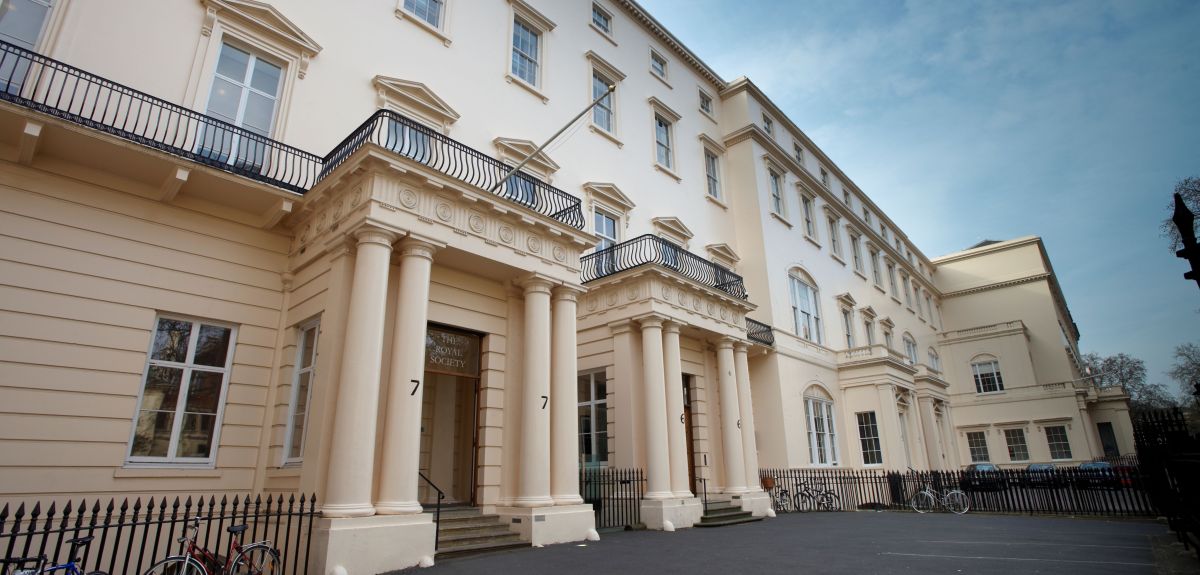
Royal Society elects eight Oxford scientists as new Fellows
Eight academics from the University of Oxford have joined the Royal Society as Fellows, including the Vice-Chancellor Professor Irene Tracey.
They have been selected for their substantial contributions to the advancement of science in various fields and are as follows:
Professor Myles Allen CBE FRS, Professor of Geosystem Science at the Environmental Change Institute, School of Geography and the Environment and Department of Physics.
Dame Sue Black, Baroness Black of Strome DBE FRS, President of St John's College, Oxford.
Professor Michael Dustin FRS, Kennedy Trust Professor of Molecular Immunology, Nuffield Department of Orthopaedics, Rheumatology and Musculoskeletal Sciences (NDORMS) and Director of Research at the Kennedy Institute of Rheumatology.
Professor Dustin said: 'It is a profound honour to become a fellow of the Royal Society. This is a remarkable privilege and opportunity that I never expected and deeply appreciate. I look forward to doing all I can to help the Royal Society deliver on its priorities.'
Dame Sarah Gilbert DBE FMedSci FRS, Said Professor of Vaccinology at the Pandemic Sciences Institute, hosted by the Nuffield Department of Medicine.
Professor Dame Sarah Gilbert, said: 'It is a great honour to be elected as a Fellow of The Royal Society. The most eminent scientists of our time are included in the Society’s Fellowship, and I’m humbled to stand alongside colleagues who are making outstanding contributions to science.
'I’m delighted to play my part in promoting and supporting excellence in vaccinology, ensuring the world is better prepared for future pandemic threats and health challenges.'
Professor Andrew Goodwin FRS, Professor of Materials Chemistry at the Department of Chemistry.
Professor James Maynard FRS, Professor of Number Theory at the Mathematical Institute.
Professor Maynard said: 'I'm delighted to be elected as a fellow of the Royal Society! It is a great honour and amazing to have my name alongside many of the most famous scientists and mathematicians throughout history (as well as several of my esteemed colleagues in Oxford) - people I was inspired by as a child starting to get an interest in mathematics.'
Professor Irene Tracey CBE FMedSci FRS, Vice-Chancellor of the University of Oxford and Professor Anaesthetic Neuroscience at the Nuffield Department Clinical Neurosciences.
Professor Scott Waddell FMedSci FRS, Professor of Neurobiology at the Centre for Neural Circuits and Behaviour.
Professor Irene Tracey, Vice-Chancellor of Oxford University, whose husband Myles Allen also became a Fellow, said: 'It is a testament to Oxford’s scientific standing to see so many colleagues honoured in this way - congratulations to all the new Fellows as well as their research teams where relevant. Naturally, Myles and I are delighted to be elected in the same year. We look forward to celebrating with colleagues and our teams, as well as serving the Royal Society in its mission to promote science.'
Sir Adrian Smith, President of the Royal Society, said: 'I am delighted to welcome our newest cohort of Fellows. These individuals have pushed forward the boundaries of their respective fields and had a beneficial influence on the world beyond.
'Among this year’s intake are individuals who were at the forefront of the response to the COVID-19 pandemic response, and those working on global challenges, from TB to climate change. They are pioneering scientists and innovators from around the world who have confounded expectations and transformed our thinking.
'This year’s intake have already achieved incredible things, and I have no doubt that they will continue to do so. I look forward to meeting them and following their contributions in future.'
Royal Society citations in full:
Professor Myles Allen CBE FRS, Professor of Geosystem Science, Environmental Change Institute, University of Oxford. Myles Allen is a climate scientist who has made ground-breaking contributions to quantitative understanding of climate change with substantial impacts on climate policy. He pioneered combining physically-based models with statistical analysis to quantify, with uncertainties, the magnitude of anthropogenic influence on observed climate change and using observations to constrain climate forecasts. He combined fundamental physics and large ensemble modelling to constrain the response in both mean and extreme precipitation to rising temperatures and increasing greenhouse gases. Furthermore, he demonstrated the cumulative impact of carbon dioxide emissions on global climate, which leads to the concept of a limited carbon budget associated with any given level of carbon dioxide-induced warming. This links directly to net zero emission targets replacing concentration stabilisation targets as the focus of climate change mitigation policy.
Dame Sue Black, Baroness Black of Strome DBE FRS, President, St John's College, Oxford. Sue Black is an internationally recognized anatomist and forensic anthropologist whose research on human morphology and biometrics has had global impact. Her research been used to assist with international war crime investigations and identify those involved in mass fatality events. She has developed methods for hand-based person identification which has enabled national and international police forces to prosecute perpetrators of child sexual abuse. Sue has been at the forefront of driving new initiatives in anatomy, raising the scientific standards of forensic anthropology, and pioneering educational primers for the judiciary. She also has an outstanding record in promoting public understanding.
Professor Michael Dustin FRS, Professor of Immunology and Director of Research, Kennedy Institute of Rheumatology, University of Oxford. Dustin is an immunologist whose research established the concept of the immunological synapse that describes how T lymphocytes recognise and respond to target cells. He pioneered the use of fluorescently tagged native molecules from antigen-presenting cells in supported planar bilayers to determine the molecules and pathways that contribute to T cell activation following antigen-recognition. He is also recognised as one of the first to develop imaging approaches to visualise the dynamics of the immune response in tissues. His work has been fundamental to the development of therapies that target the T cell response including in the field of vaccines and immune-oncology.
Dame Sarah Gilbert DBE FMedSci FRS, Said Professor of Vaccinology at the Pandemic Sciences Institute, hosted by the Nuffield Department of Medicine, University of Oxford. Dame Sarah Gilbert has pioneered a range of approaches for vaccines targeted at emerging pathogens. She led the development of the ChAdOx vaccine platform, demonstrating its use to make clinically protective vaccine against Middle East Respiratory Syndrome and leading programmes in Nipah and Lassa fever. In 2020, she was responsible for a team effort to adapt ChAdOx1 to express the SARS-CoV-2 spike protein for development of a novel vaccine against COVID-19. The ChAdOx1 SARS-CoV-2 vaccine was shown safe and protective against virus in the lungs and is estimated to have saved 6.3 million lives in the first year of rollout.
Professor Andrew Goodwin FRS, Professor of Materials Chemistry, Department of Chemistry, University of Oxford. Andrew Goodwin is distinguished for his seminal contributions to the study of correlated disorder in materials, and for discovering solids with counterintuitive mechanical properties, such as negative compressibility. He has pioneered novel approaches, now used worldwide, for interpreting both diffuse scattering and correlated disorder itself. He has discovered unexpected defect structures in a variety of technologically important materials and established methodologies for optimising performance through disorder engineering. His work has significantly impacted many important fields, including energy storage, frustrated magnetism, and biomineralogy. Goodwin was the first Blavatnik Laureate, recognised for his ground breaking theoretical and applied studies of disorder and flexibility.
Professor James Maynard FRS, Professor of Number Theory, Mathematical Institute, University of Oxford. James Maynard has many spectacular works in analytic number theory, particularly the theory of prime numbers. He developed a new method in sieve theory and applied it to find bounded gaps between consecutive primes, and then to find the largest known gaps between consecutive primes. He combined sieve theory and Fourier analysis to show that there are infinitely many primes missing any given digit in their decimal expansion. With Koukoulopoulos, he developed novel combinatorial methods to resolve the longstanding Duffin-Schaeffer conjecture in diophantine approximation. In a monumental series of recent works, he has substantially advanced our understanding of the distribution of primes in arithmetic progressions. James Maynard was awarded the Fields Medal in 2022.
Professor Irene Tracey CBE FMedSci FRS, Vice-Chancellor & Professor Anaesthetic Neuroscience, University of Oxford. Irene and her team developed new approaches to uncover how the human brain constructs and modulates the perception of pain in health and disease. Pioneering the use of neuroimaging with novel paradigm designs, their work has given mechanistic insight into how injury, cognition, context and mood produce and influence the experience of pain in acute and chronic pain states. Their work conducted at WIN (formerly FMRIB) in the Nuffield Department of Clinical Neurosciences has contributed to a fundamental change in how we view pain as an emergent experience that is not simply related to nociception and injury. Her team has also transformed our understanding of how anaesthetics produce altered states of consciousness. Their work spans discovery through translation to industry, the clinic and society. Irene is currently President of the Federation of European Neuroscience Societies (FENS).
Professor Scott Waddell FMedSci FRS, Professor of Neurobiology, Centre for Neural Circuits and Behaviour, University of Oxford. Scott Waddell discovered novel, conserved mechanisms of adaptive behaviour. His studies in Drosophila revealed an unexpected degree of specialization in the structure and function of dopaminergic circuits. Different, genetically and structurally defined, dopaminergic neurons provide valence and even reward type-specific teaching signals. Opposing systems of positive and negative reinforcement control goal-directed memory formation and expression at discrete anatomical sites. When learned expectations are not met, the original memory remains but is updated by integration with a new memory of opposite sign at a separate location. Intelligent behaviour is therefore informed by a catalogue of parallel memories accrued over time.
 Expert Comment: Why cherish the analogue in a digital age?
Expert Comment: Why cherish the analogue in a digital age?
 New Year Honours 2026
New Year Honours 2026
 New study estimates NHS England spends 3% of its primary and secondary care budget on the health impacts of temperature
New study estimates NHS England spends 3% of its primary and secondary care budget on the health impacts of temperature
 International collaboration launches largest-ever therapeutics trial for patients hospitalised with dengue
International collaboration launches largest-ever therapeutics trial for patients hospitalised with dengue